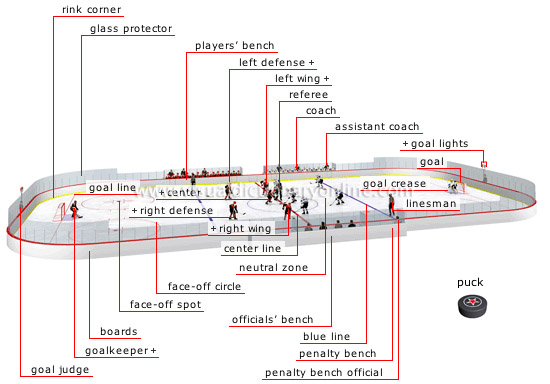rink
Ice surface on which a hockey game is played; a game consists of three 20-minute periods with two 15-minute intermissions.
glass protector 
Reinforced glass panel that is mounted on top of the boards to protect spectators from high shots and players’ sticks.
goalkeeper 
Player whose role is to prevent the puck from entering the goal; the goalkeeper usually plays the entire game.
goal line 
Red line that the puck must cross for a goal to be scored; the red line also marks the icing line.
face-off spot 
Each of the spots where a referee or linesman drops the puck to put it in play.
face-off circle 
Circle around each of the five face-off spots; two players line up on each side of this spot for a face-off while the other players remain outside the circle.
left defense 
Position to the left of the center and behind the wing; this player tries to prevent the opponent from approaching the goal.
boards 
Wooden or fiberglass boards that surround the rink and delimit the playing area.
players’ bench 
Bench used by the coaches and by inactive players; each team has about 20 players but only six are on the ice at the same time.
right defense 
Position to the right of the center and behind the wing; this player tries to prevent the opponent from approaching the goal.
rink corner 
The four rounded corners of the rink where body checks are often thrown.
goal judge 
Off-ice official who is positioned at the end of the rink behind the goal; the goal judge turns on a red light when the puck crosses the goal line.
assistant coach 
Person who assists the coach; there are usually two assistant coaches behind the bench, one in charge of the offense and the other in charge of the defense.
coach 
The team’s leader; the coach plots strategy and decides who plays in different situations.
goal lights 
The red light signals a goal while the green light, which is connected to the official time clock, signals a stoppage in play or the end of a period.
penalty bench official 
Official who is responsible for maintaining order on the penalty bench.
neutral zone 
Area between the two blue lines where player changes are made and where various offensive and defensive strategies are initiated.
left wing 
Offensive position to the left of the center; this player’s role is to score goals and to check the opposing left wing.
penalty bench 
Bench reserved for penalized players; penalties vary between two and 10 minutes, depending on the seriousness of the infraction.
officials’ bench 
Bench reserved for some of the off-ice officials (timekeeper and penalty keeper, scorer, announcer).
center 
Player who usually takes the face-offs; a key player on a team, the center plays an offensive and a defensive role.
goal 
Cage formed of netting mounted on a metal frame; a team scores a goal each time it lodges the puck inside the opposing goal.
goal crease 
Semicircle reserved for the goalkeeper; the referee disallows a goal if a player interferes with the goalkeeper inside the goal crease.
blue line 
Two lines that divide the rink into three equal parts; an offside is called when a player crosses the opposing blue line before the puck.
referee 
Official who is responsible for applying the rules; the referee, who wears a red armband, officiates and drops the puck for face-offs at the start of a period.
center line 
Line that divides the rink into two zones, one for each team; teams change zones after each period.
right wing 
Offensive position to the right of the center; this player’s role is to score goals and to check the opposing right wing.
linesman 
One of two officials who signal offsides and icings; they do most of the face-offs and also signal infractions to the referee.
puck 
Black disk that is made of hard rubber; the puck is refrigerated before a game to improve its sliding action and reduce bouncing.

























